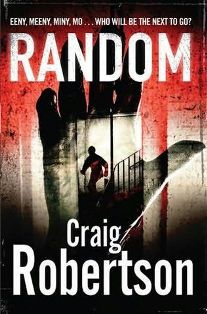
First published in April of 2010, Glasgow Sunday Post’s Craig Robertson’s debut novel ‘Random’ was a brave venture into the world of crime fiction for the Scottish journalist. That said, he writer’s twenty-odd-years of experience in the field of reporting have allowed him to build up a solid platform of knowledge around the ins and outs of real-life police investigations and the like.
DLS Synopsis:
Reynolds is a forty-odd-year-old serial killer terrorizing the city of Glasgow. Jumping on the story, the daily tabloids initially dub the killer ‘Jock the Ripper’ until Reynolds decides to apply his own preferential name – ‘The Cutter’.
Reynolds’s victims are predominately chosen at random, although it slowly emerges that one of the victims doesn't quite fit this mould. In fact, the victim in question has an important connection with the killer.
However, when Reynolds murders his third successive victim, Thomas ‘Spud’ Tierney, a small-time Easterhouse drug dealer, Glasgow’s psychotic head-gangster Alec Kirkwood takes exception to the murder of one of his associates and decides to get involved.
However, Reynolds’ cold and callous mind together with his intrinsically controlled approach to the murders leaves little to no leads for the investigating police officers. The police are stumped, with little hope of catching the killer as they wait for the next victim to be revealed to them. Toying with the police, Reynolds tags each of his killings (all but one that is) by removing the victims’ little finger using a pair of gardening secateurs and then posting the severed digit to the police (although in one case the killer sends the gruesome trophy to the Chief Reporter for the Daily Record - Keith Imre).
Each murder is as different and elaborate as the one that preceded it. However, Reynolds’ carefully devised crimes are beginning to show the first signs of cracks in their execution. Detective Sergeant Rachel Narey, who is leading the police investigation, already has her suspicions. And the ruthless head-gangster Kirkwood is stopping at nothing to find out the identity of the killer for himself. How long will these killings go on for? Who will get to the killer first? And is there a connection between the killer and any of his supposedly random victims after all?...
DLS Review:
Robertson’s debut is certainly a tension building thriller that plays heavily on the psychological and emotional aspects of a modern day serial killer. The classic ‘serial killer profile’ is quickly cast aside, as are the typical motivations for such multiple murders. Indeed, the author's surprising use of the first-person-perspective through the eyes of the killer allows the reader to glimpse a chilling insight into the mind, actions and emotions of the man behind this chain of random murders. This works incredibly well, reeling the reader into the horror of the storyline from this powerfully emotive viewpoint.
In doing so, the characterisation of Reynolds is lovingly nurtured and very carefully developed upon, revealing a complex array of layers that, when peeled away, ultimately expose a surprising (and utterly hauntingly) ‘human’ individual. Once the cold mask has been removed and the narrative delves into Reynolds’ true thoughts, the reader is soon coerced into feeling something close to a very difficult empathy for the man - however hard it is to accept.
Glimmers of regret for some of his victims start to show, leading the reader further down the path of actually siding with this emotionally battered individual. This is clearly not a run-of-the-mill psycho hellbent on murder. There is depth to the man. Raw and bitter emotions running wild. There is no black and white evil here.
Although Robertson keeps hold of a tightly written storyline, the author does find himself getting a little bogged down in his true crime history. Although the insight this brings into the killer's own knowledge on serial killers is an important aspect of his characterisation (and to the intrinsically analytical approach he has to plotting the murders), the chapter that is almost entirely consumed by a ‘serial killer oversight’ simply ends up fragmenting the otherwise fluid pace of the novel.
The overall gritty feel to the storyline plays an important role with the downbeat atmosphere of the tale. The novel finds itself loosely fitting somewhere between the likes of Bret Easton Ellis’ ‘American Psycho’ (1991), David Fincher’s movie ‘Se7en’ (1995) and perhaps even Shaun Jeffery’s novel ‘The Kult’ (2009).
The storyline builds towards a powerfully emotional ending, rather than the typically action filled finale that you may well have expected. However, this is certainly in keeping with the underlying emotional thrust of the novel, which concludes in a bitterly poetic fashion.
Although the novel plays well with the emotional and psychological aspects of the characters involved, the overall pace and flow of the story is too disjointed and forgotten. The elaborate deaths fail to deliver the intended impact that is required, the investigating officers are pushed too far into the background and the ‘plot-swaying-twists’ miss their mark somewhat with their execution. Too much of the novel is left with a calm and cold approach, without the impactful jolts of action that the storyline really requires.
All in all, the tale is an intriguing and involved story that pulls the reader in to the psychological questions that revolve around our principal character and narrator. The dwindling pace, premise and main body of the story are just enough to keep the reader intrigued enough to keep reading. However, the novel as a whole does feel disjointed, slightly too vague in its subplots and misses the importance of impact on a number of key occasions.
The novel runs for a total of 329 pages.
© DLS Reviews






